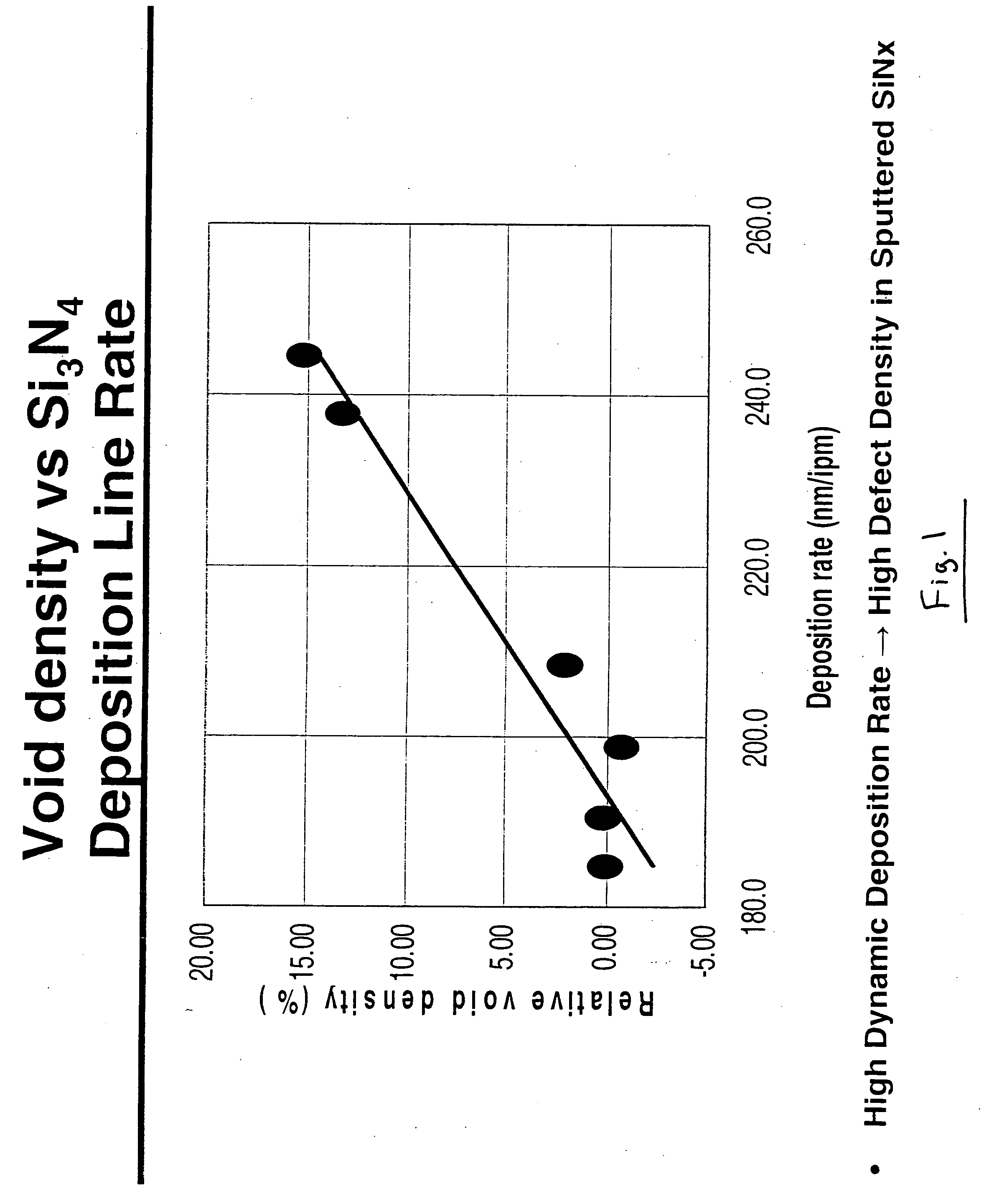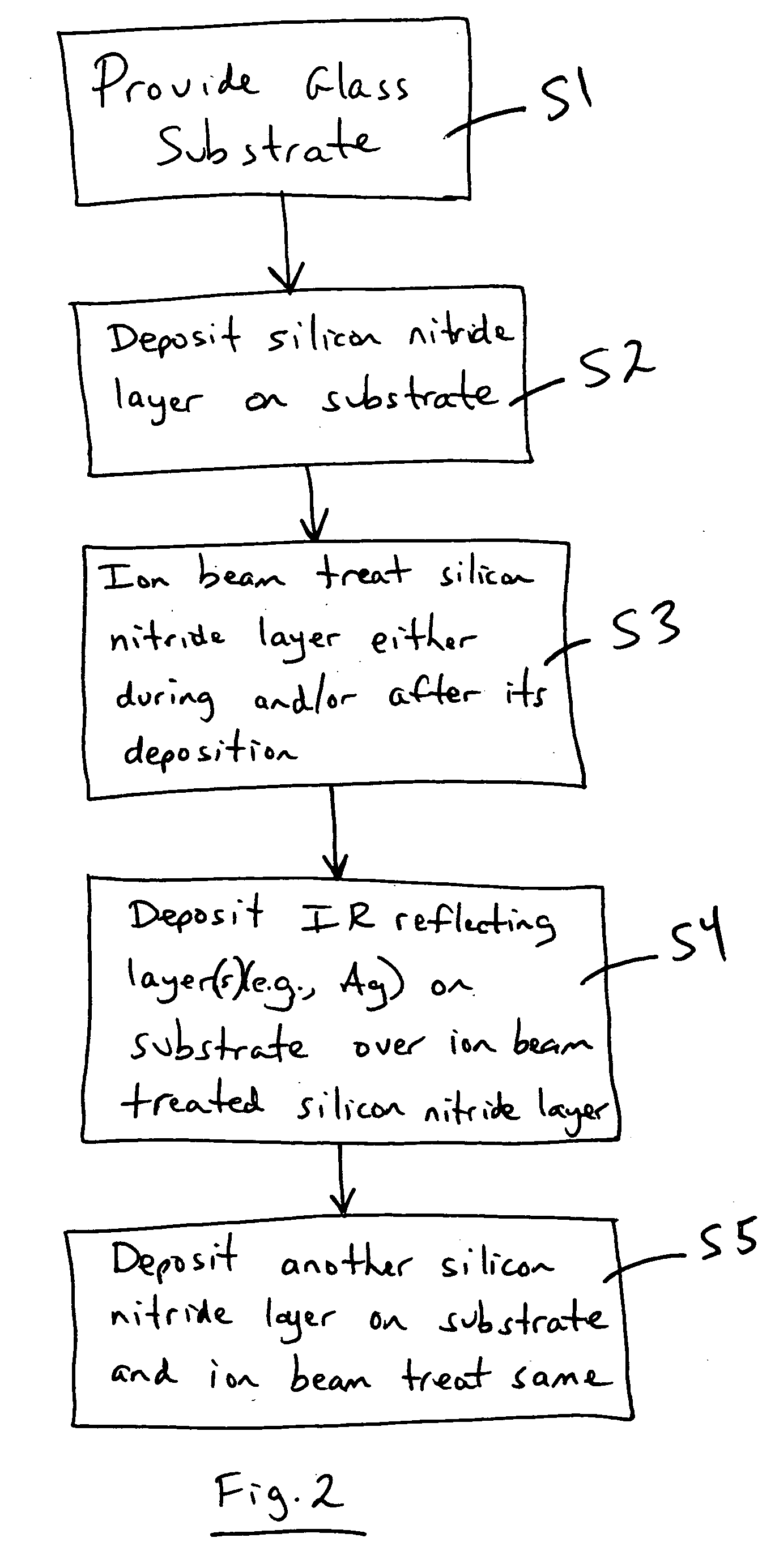Coated article with ion treated underlayer and corresponding method
a technology of ion treatment and coating article, which is applied in the direction of vacuum evaporation coating, electric/magnetic/electromagnetic heating, transportation and packaging, etc., can solve the problems of undesirable drop in visible transmission, undesirable color shift of product, and difficult to obtain high visible transmission and adequate solar control properties. , to achieve the effect of less structural defects, less reactive, and less sodium migration
- Summary
- Abstract
- Description
- Claims
- Application Information
AI Technical Summary
Benefits of technology
Problems solved by technology
Method used
Image
Examples
examples 1-3
[0078] Examples 1-3 illustrate example techniques for forming layers 3 and / or 25, or any other suitable layer according to example embodiments of this invention. Examples 1-3 utilized IBAD type of ion beam treatment, and were made and tested as follows. A silicon nitride layer was deposited on a quartz wafer (used for ease of stress testing) using IBAD (e.g., see FIG. 8) under the following conditions in the deposition chamber: pressure of 2.3 mTorr; anode / cathode ion beam source voltage of about 800 V; Ar gas flow in the ion source of 15 sccm; N2 gas flow in the ion source 26 of 15 sccm; sputtering target of Si doped with about 1% boron; 460 V applied to sputtering cathode; 5.4 sputtering amps used; 60 sccm Ar and 40 sccm N2 gas flow used for sputtering gas flow; linear line speed of 50 inches / minute; where the quartz wafer substrate was circular in shape and about 0.1 to 0.15 mm thick. The ion beam treatment time for a given area was about 3 seconds.
[0079] Example 2 was the same ...
example 4
[0083] Example 4 used post-sputtering peening type of ion beam treatment, and was made and tested as follows. A silicon nitride layer about 425 Å thick was deposited by conventional magnetron-type sputtering using a Si target doped with Al on a substrate. After being sputter-deposited, the silicon nitride layer had a tensile stress of 400 MPa as tested on the quartz wafer. After being sputter-deposited and stress tested, the silicon nitride layer was ion beam treated using an ion source 26 as shown in FIGS. 6-7 under the following conditions: ion energy of 750 eV per N ion; treatment time of about 18 seconds (3 passes at 6 seconds per pass); and N2 gas used in the ion source. After being ion beam treated, the silicon nitride layer was again tested for stress, and had a tensile stress of only 50 MPa. Thus, the post-sputtering ion beam treatment caused the tensile stress of the silicon nitride layer to drop from 400 MPa down to 50 MPa (a drop of 87.5%).
example 5
[0084] The following hypothetical Example 5 is provided for purposes of example only and without limitation, and uses a 2.1 mm thick clear glass substrates so as to have approximately the layer stack set forth below and shown in FIG. 3. The layer thicknesses are approximations, and are in units of angstroms (A).
Layer Stack for Example 5
[0085]
LayerGlass SubstrateThickness (Å)N-doped Si3N4100ZnAlOx109Ag96NiCrOx25SnO2535SixNy126ZnAlOx115Ag95NiCrOx25SnO2127N-doped Si3N4237
[0086] The processes used in forming the coated article of Example 5 are set forth below. The sputtering gas flows (argon (Ar), oxygen (O), and nitrogen (N)) in the below table are in units of sccm (gas correction factor of about 1.39 may be applicable for argon gas flows herein), and include both tuning gas and gas introduced through the main. The line speed was about 5 m / min. The pressures are in units of mbar x 10−3. The silicon (Si) targets, and thus the silicon nitride layers, were doped with aluminum (Al). The Z...
PUM
| Property | Measurement | Unit |
|---|---|---|
| compressive stress | aaaaa | aaaaa |
| sheet resistance | aaaaa | aaaaa |
| sheet resistance | aaaaa | aaaaa |
Abstract
Description
Claims
Application Information
 Login to View More
Login to View More - R&D
- Intellectual Property
- Life Sciences
- Materials
- Tech Scout
- Unparalleled Data Quality
- Higher Quality Content
- 60% Fewer Hallucinations
Browse by: Latest US Patents, China's latest patents, Technical Efficacy Thesaurus, Application Domain, Technology Topic, Popular Technical Reports.
© 2025 PatSnap. All rights reserved.Legal|Privacy policy|Modern Slavery Act Transparency Statement|Sitemap|About US| Contact US: help@patsnap.com



